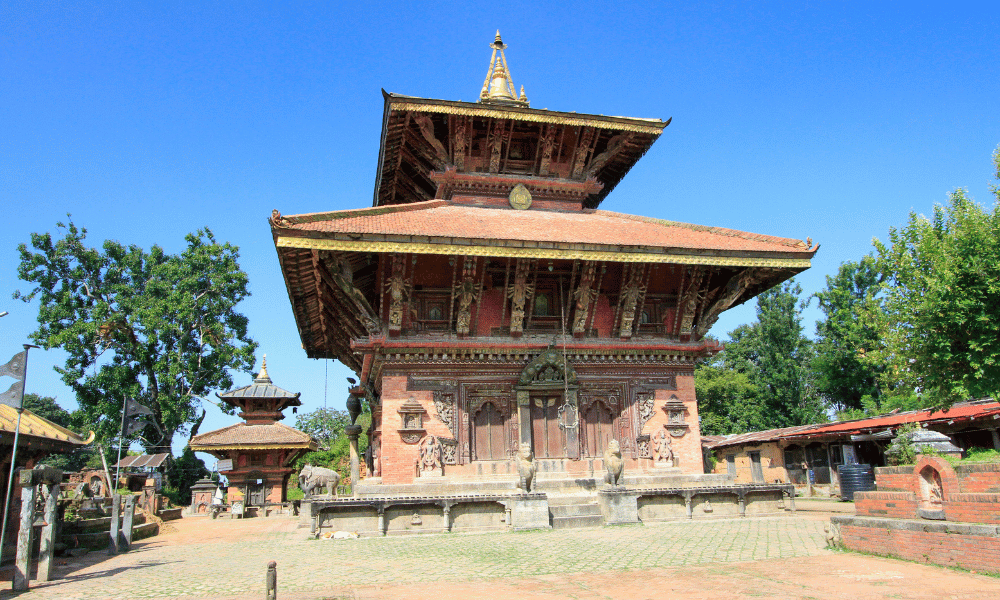Nepal, a country where multi-religious faiths coexist to weave a beautiful tapestry of harmony, is a testament to this country's beauty. Here, people of diverse religions reside with feelings of cooperation and contribution. Among different religions, Hinduism is the predominant religion in this country, accounting for more than 80% of the whole population. As a result, there are a significant number of Hindu temples in the country. Among these sacred sites, the Changu Narayan Temple emerges as a jewel in Nepal's crown, revered as one of the most significant Vishnu temples in the country and counted among the revered 108 Divya deshams. The temple is also one of the four Narayans of the Kathmandu valley, the others being Ichangu Narayan, Bishanku Narayan, and Shesh Narayan. The four Narayans are scattered in 4 cardinal directions in the Kathmandu valley.
Nestled atop a serene hill on the outskirts of Bhaktapur city, the Changu Narayan Temple stands as a timeless monument to devotion and architectural brilliance. Its origins date back to ancient times, with historical records tracing its establishment to the year 326 AD. Dedicated to Lord Vishnu, the deity regarded as the preserver of the universe in Hindu mythology, the temple radiates an aura of divine grace and spiritual enlightenment. The architectural grandeur of Changu Narayan, adorned with intricately carved sculptures and embellishments, serves as a testament to the unparalleled craftsmanship of ancient Nepali artisans. Each nook and cranny of the temple complex whispers tales of a bygone era, inviting pilgrims and travellers to immerse themselves in the rich cultural heritage of Nepal.
Beyond its physical magnificence, Changu Narayan holds a profound significance in the hearts and minds of Nepali people. It serves not only as a place of worship but also as a symbol of resilience and cultural identity. Through the ages, the temple has withstood the test of time, bearing witness to the tides and flows of history while remaining steadfast in its devotion to Lord Vishnu. As pilgrims flock to its sacred precincts, they are not merely seeking blessings; they are forging a connection to a heritage that transcends generations. In the following exploration of Changu Narayan Temple, we will unravel the layers of its mythic past, marvel at its architectural splendour, and delve into the depths of its cultural and spiritual significance, discovering the timeless truths it holds for Nepali culture and beyond.
Also Read: 12 Must Visit Hindu Temples in Nepal
Changu Narayan Facts
|
Site |
Changu Narayan |
|
Affiliation |
Hinduism |
|
Deity |
Lord Vishnu |
|
Location |
Changu Narayan, Bhaktapur |
|
Established by |
Licchavi King Haridatta Barma (Believed) |
|
Major Attractions |
|
|
Major Celebrations |
|
|
Style |
|
|
Opening Hours (main temple) |
04:00 AM–10:00 PM |
|
Entry Fee |
|
History and Mythology
Believed to be the oldest temple in Nepal, the actual history of the temple is shrouded in mystery. The earliest recorded information about the temple is from the period of Lichavi King Mana Deva, who reigned from 496 A.D. to 524 A.D. The first epigraphic evidence of Nepalese history found in the temple premises during the reign of the Licchavi King Manadeva, dating back to 464 A.D. shows that Changu had already been established as a sacred site in the 3rd century A.D. It is the earliest inscription known in Nepal. The temple was restored during the lifetime of Ganga Rani, consort of Siva Simha Malla, who reigned from 1585 to 1614. There are records of the temple burning in the year 822 Nepal Samvat (1702 A.D.), after which reconstruction was carried out. The temple has stood through many monarchial and political changes during its long years.

More recently, the Gorkha Earthquake of April 2015 damaged 753 temples, shrines, and monasteries across Nepal, including 241 in Kathmandu. Changu Narayan suffered heavy damage, but restoration projects began almost immediately. It was reopened the same year, and the Department of Archaeology announced that the restoration project had been completed in November 2017. Now the temple is restored completely and shines its benevolence on the devotees who come seeking the Lord's blessings. Not only do people come to visit it for its religious importance but also for its sheer beauty, its art, architecture, and idols. It is considered to be the most beautiful temple in Nepal.
While talking about the mythology related to the Changu Narayan Temple, the story goes like:
Long ago, a Gwala (cow herder) bought a cow that was renowned for producing a large quantity of milk from a brahmin named Sudarshan. After buying, the Gwala then used to take the cow to the forest of Changu to graze in the morning every day. While grazing, the cow used to always head to the shade of a particular tree. In the evening, when Gwala took the cow home and started milking, it produced less milk than he anticipated. He didn’t think much of it for the first few days.
Even after waiting for days, the cow did not give milk as much. Then the Gwala became sad and frustrated and complained about it to the brahmin (the previous owner). The brahmin also observed the facts with his own eyes and planned with the Gwala to investigate the activities of the cow during the day. The cow went to the shade of the same tree that she visits every day. To their surprise, they saw the cow being fed on by a black boy who emerged from the tree. They thought the boy was an evil spirit and decided to cut down the tree, believing that it was the source of the evil. While cutting, fresh human blood came out of the cut they made on the tree. Thinking that they had committed a great sin, they started praying to God for forgiveness. After a while, Lord Vishnu came out of the tree and assured them that it was not their fault.
Lord Vishnu told them Lord Vishnu told them the story that he had committed a heinous crime by killing Shudarshan’s father unknowingly while hunting in the forest. After that, he was cursed for the crime. He then wandered on earth at Garuda’s mouth, eventually descending the hill at Changu. There he lived in anonymity, surviving on milk stolen from a cow. When Brahmin cut down the tree, Lord Vishnu was beheaded, which freed Lord Vishnu from his sins. After hearing these words from Vishnu, Brahmin and Gwala started worshipping the place and established a small temple in the name of Lord Vishnu. Ever since that day, the site has been held sacred.
Religious and Cultural Significance
Changu Narayan Temple holds a paramount position in the cultural and religious fabric of Nepal, serving as a sacred sanctuary where ancient traditions converge with contemporary reverence. For Nepali people, the temple embodies a sense of cultural identity and pride, symbolising the rich tapestry of religious diversity and spiritual heritage that defines the nation. As a UNESCO World Heritage Site, Changu Narayan stands as a testament to Nepal's cultural legacy, preserving centuries-old customs and rituals for future generations to cherish and celebrate.
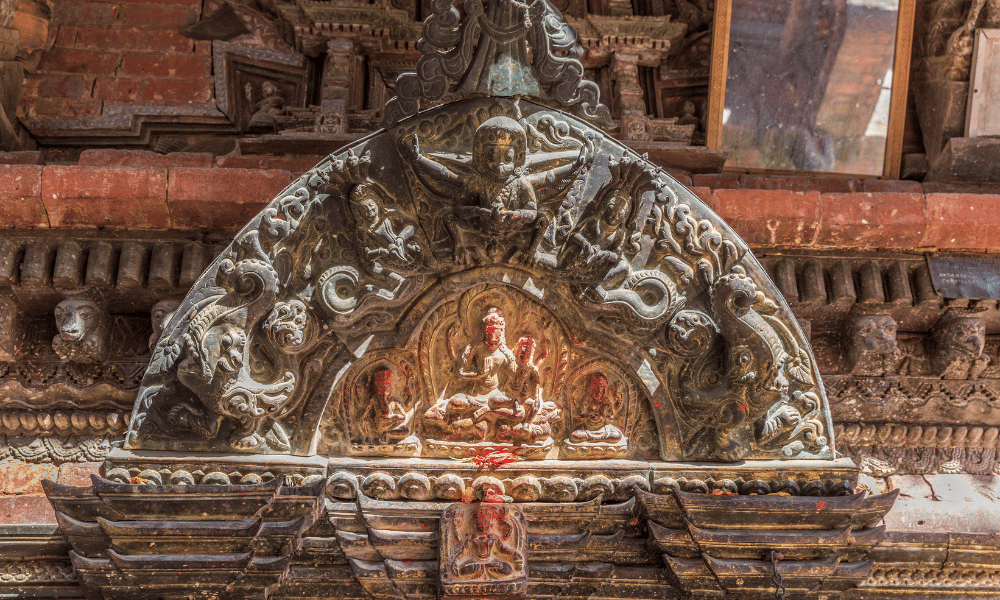
Religiously, Changu Narayan is revered as the abode of Lord Vishnu, the preserver of the universe in Hindu mythology. Devotees flock to the temple to seek blessings for prosperity, health, and happiness, believing that a pilgrimage to Changu Narayan is a sacred journey of spiritual purification and enlightenment. Rituals and ceremonies are conducted daily within the temple precincts, ranging from elaborate pujas to simple offerings of flowers and incense. Each ritual serves as a symbolic expression of devotion and reverence, reinforcing the bond between the worshipper and the divine.
Moreover, Changu Narayan Temple serves as a focal point for religious festivals and cultural celebrations throughout the year. From the vibrant colours of Dashain to the solemnity of Maha Shivaratri to the sacred awakening of Haribodhini Ekadashi, the temple grounds come alive with the sounds of prayers and the aroma of incense as devotees gather to pay homage to Lord Vishnu and other deities around the temple premises. Changu Narayan also hosts a local cultural festival called the Kalash Yatra/Jatra, which is celebrated by Newari locals in the Changu area. These festivals not only deepen the spiritual connection of the faithful but also foster a sense of community and solidarity among Nepal's diverse religious communities, transcending barriers of caste, creed, and ethnicity. As such, Changu Narayan Temple stands as a beacon of unity and harmony, embodying the timeless values of tolerance, compassion, and respect that lie at the heart of Nepal's cultural and religious heritage.
Major Attractions
Though the temple is the major attraction of the Changu area, other significant attractions are present around the temple area, such as:
The Temple’s Complex
Changu Narayan Temple stands as a majestic testament to Nepali craftsmanship and spiritual devotion; its architectural design is a captivating blend of tradition and innovation. Rising proudly atop a stone base, this two-story temple is adorned with intricate carvings and divine idols representing the various avatars of Lord Vishnu, rendering it one of the most visually stunning temples in Nepal. The fusion of pagoda and Newari architectural styles lends the temple a unique charm, reflecting the rich cultural heritage of the region.

There are 4 pairs of animal gatekeepers, Elephants, Lions, Griffins, and Sarabhas in front of each cardinal entrance gate of the temple. Stone monoliths in front of the temple are clamped with Sankha and Chakra and supported by stone turtles at the base. Similarly, the premise contains the oldest stone inscription erected by King Mandev in 464 AD. A statue of Vishnu’s Bahan (ride) Garuda is seen in front of the temple’s main entrance. The sculpture of Garuda Narayan is so well made that it has been watermarked on a 10 rupee Nepali note. On the side of Garuda is a 17th-century statue of King Bhupatindra Malla with Queen Bhuwan Laxmi. The temple premise houses many other old stone sculptures from the 7th century, which makes Changunarayan a world heritage site. The sculpture of Narshima depicting a lion-human figure of Lord Vishnu killing the demon Hiranyakashipu, the sculpture showing Vishnu Vikrant crossing the universe in one step, the sculpture of Vishwaroopa, where Shree Krishna is showing his cosmic form to Arjuna, and more.
At the heart of Changu Narayan Temple lies its crowning glory: the sloped roof supported by wooden studs intricately carved with depictions of Lord Vishnu's cosmic avatars. These divine forms, each imbued with symbolic significance, speak to the temple's spiritual essence and the reverence with which it is held by devotees. Additionally, the roof is held aloft by four corner studs adorned with the Sharabha form of Lord Shiva, a mythical creature said to have calmed the fierce Narsimha form of Lord Vishnu. This divine imagery, woven into the very fabric of the temple's architecture, serves as a reminder of the eternal cosmic dance between creation and destruction, preservation and transformation. The temple houses an idol of Lord Narayana, who is the primary deity of the Changu Narayan Temple.
As visitors wander through the temple grounds, they are greeted by a profusion of artistic treasures, each telling a story of devotion and divine grace. The temple's walls are adorned with intricate carvings of gods, goddesses, and celestial beings, showcasing the skill and craftsmanship of generations past. The intricate stone lattice-work, known as "jali," allows light to filter into the temple, creating a serene and ethereal ambience within its hallowed halls. From its majestic facade to its inner sanctum, Changu Narayan Temple's structure is a testament to the rich cultural heritage and spiritual legacy of Nepal, inviting visitors to marvel at its beauty and immerse themselves in its sacred atmosphere.
Bas-Relief of Vishnu Mounting Garuda
Garuda is a mythical creature considered a deity in Hinduism; primarily, he is depicted as the mount of Lord Vishnu. He is the son of the sages Kashyapa and Vinata. Garuda is described as the king of birds, and the sworn enemy of the Nagas. As depicted in the ancient texts, Garuda has 2 forms, one is the full bird form, where he turns into an eagle, and the half human half bird form, in which he has the face of a bird and the body of a human with wings. The Bas-Relief of Vishnu Mounting Garuda is a beautiful and captivating artwork located in the northeast corner of the courtyard of the Changu Narayan temple. In this statue, Garuda is in his half human half bird form, and Lord Vishnu is riding on top, holding his sacred weapons.

The bas-relief is also significant from a religious point of view. In Hinduism, Vishnu is considered to be the preserver of the universe, and the act of him riding on the back of Garuda is symbolic of his power and control over the natural world. It is also a representation of the relationship between Vishnu and Garuda, who is considered to be Vishnu's mount and faithful servant.
Idol of Vishnu Vishwarup
The idol of Vishnu Vishwarup is one of the main attractions at the temple and is an iconic representation of Lord Vishnu and his many facets. The idol of Vishnu Vishwarup is an amazing artwork said to have been made thousands of years ago. Lord Vishnu is depicted having multiple heads and multiple hands carrying many of his sacred weapons. This multi-limbed depiction is meant to symbolise the omnipresence of Lord Vishnu and his control over all aspects of the universe. The Vishwarup is surrounded by many gods and angel looking figures, some holding him and some bowing their heads and greeting him with Namaskara. And at the base of this idol is the reclining Vishnu figure laying on top of the Shesh Naga.
Changu Museum
The Changu Museum is a privately owned museum that is located halfway up the temple. It is owned by Mr. Baishnav Raj Shrestha, who also oversees the preservation and maintenance work of the museum.
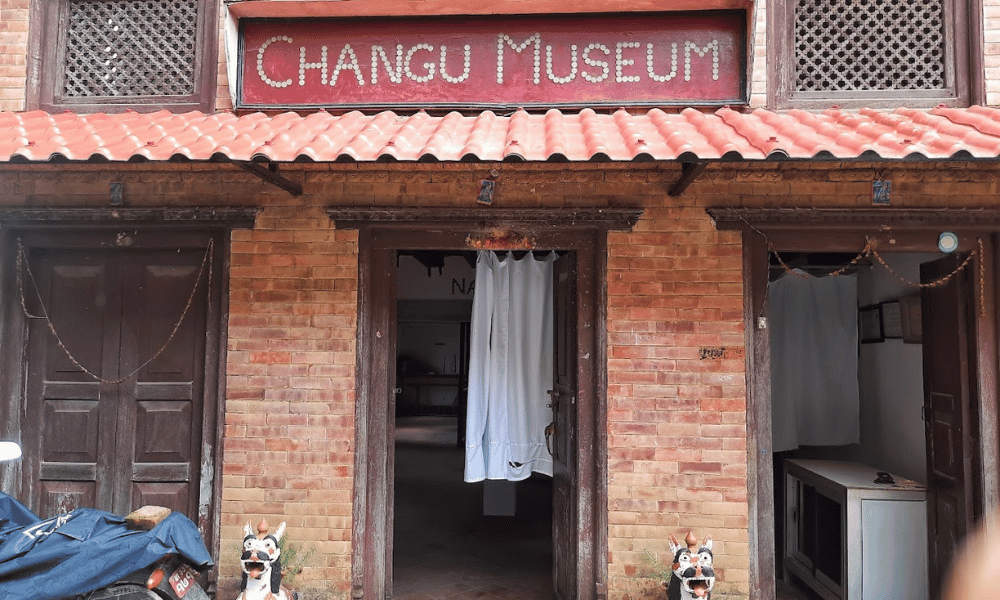
This museum consists of the artistic history of Changunarayan, cultural musical instruments, Lakhe dance, old armouries, indigenous rice varieties, and traditional weighing instruments like mana, pathi, dhak, and taraju. Additionally, varieties of Nepali traditional caps, ancient literature, and different coins and currency notes from the Malla period have been accumulated and stored in the museum. The museum consists of the faces of Malla Kings Narendra Dev and Shiva Singh Malla. Further, various traditional utensils, conch shells, and thangkas made up of mud used in different rituals like marriage ceremonies, Bratabandha, and Shraadh are preserved within this museum. The top floor consists of a traditional Newari dining room, and visitors can also view and enjoy the natural scenic beauty of Kathmandu Valley from the roof of this museum.
Related Read: Museums In Kathmandu
Living Traditions Museum (LTM)
The Living Traditional Museum, located in the Changu Narayan Temple Complex, is a type of museum that showcases the artistic and cultural traditions within the four primary regions of Nepal. The museum houses a number of traditional and cultural artefacts from the past. It contains daily essential items that were used in the past, like some traditional clothes, boots, utensils, musical instruments, weapons, tools, decorative items,etc.
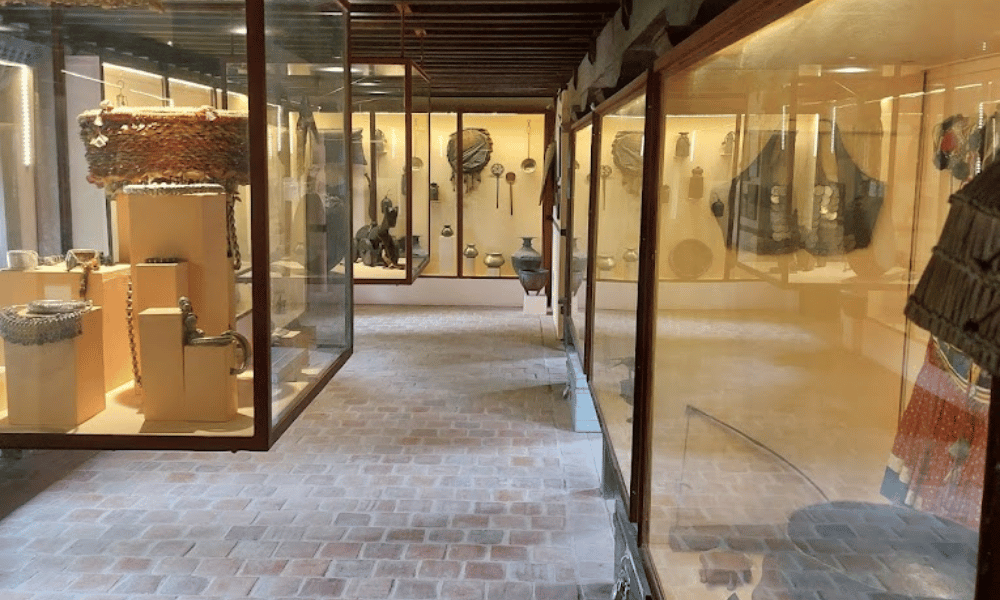
The main objective of this museum is to display the diverse and rich cultural heritage of the area, with a particular focus on the traditional customs, beliefs, and practices of Nepal. The unique and intricate pieces inside the museum provide a fascinating insight into the traditional craftsmanship and artistic skills of the Nepalese people and are a testament to their rich cultural heritage.
Pillar erected by Mandeva
At the Changu Narayan Temple, nestled within the Kathmandu Valley, a pillar adorned with intricate inscriptions stands as a testament to the enduring legacy of Manadeva. Carved with precision and adorned with motifs that speak of ancient wisdom and devotion, this pillar is not merely a physical structure but a profound symbol of Nepal's spiritual and cultural heritage. Manadeva's name, revered for his patronage of art and spirituality, is etched into the stone, preserving his contributions to the temple's rich tapestry of history. Through the inscriptions, visitors are transported back in time, connecting with the traditions, rituals, and beliefs of bygone eras and gaining insight into the profound reverence with which the temple has been held for centuries.

As visitors explore the temple complex, the pillar with Manadeva's inscriptions becomes a focal point of contemplation and reflection. It stands amidst the serene surroundings, inviting seekers of truth to pause and absorb the wisdom encapsulated within its ancient words. Each stroke of the chisel tells a story, weaving together the narratives of kings, kingdoms, and the divine. As the sun sets over the valley, casting a warm glow upon the temple's ancient stones, the inscriptions on the pillar continue to echo the timeless truths of faith and devotion, inspiring all who pass through the sacred confines of Changu Narayan.
Shrines of other Hindu Deities
Within the Changu Narayan Temple complex, amidst the grandeur of the main temple dedicated to Lord Vishnu, several smaller shrines stand as silent guardians, each venerating a different aspect of Hindu mythology and spirituality. Among these sacred structures is the Kileshwor Mahadev Temple, devoted to Lord Shiva, the destroyer and transformer within the Hindu pantheon. Here, devotees offer prayers and perform rituals to seek the blessings of Shiva, who is believed to bestow strength, wisdom, and protection upon his devotees. The Kileshwor Mahadev Temple exudes a serene ambience, drawing worshippers seeking solace and spiritual guidance amidst the bustling activity of the temple complex.
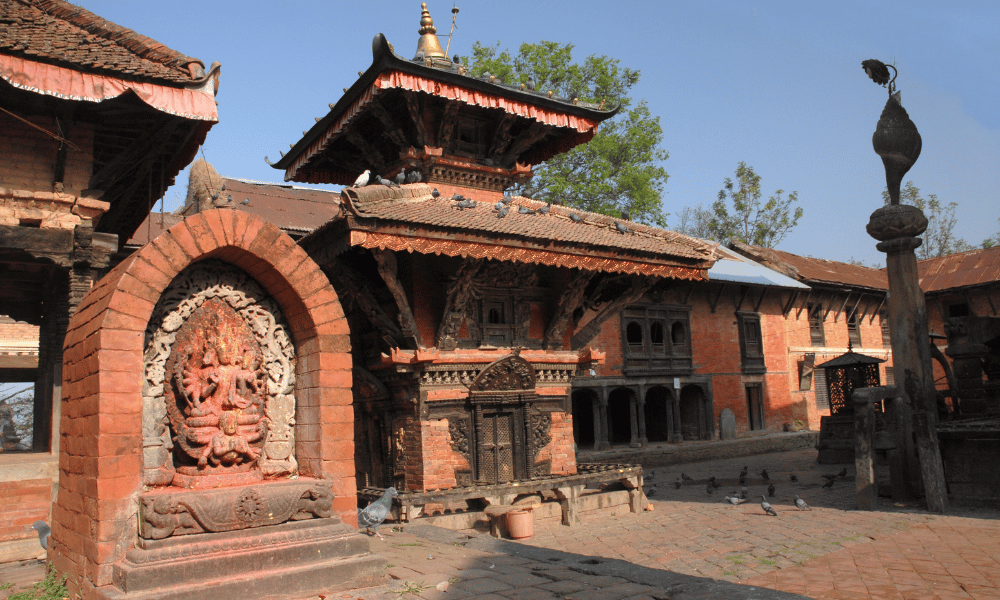
Another notable shrine within the Changu Narayan Temple complex is dedicated to Chhinnamasta, a unique and enigmatic form of the goddess Durga. Chhinnamasta is depicted as a goddess holding her own severed head, symbolising the transcendence of the ego and the triumph of self-sacrifice over worldly desires. Devotees revere Chhinnamasta as a symbol of courage, fearlessness, and spiritual awakening. The shrine dedicated to Chhinnamasta serves as a focal point for those seeking inner strength and enlightenment, offering a sacred space for reflection and contemplation within the bustling temple complex.
Major Festivals
The temple holds many festivals throughout the year, dedicated to different deities. These celebrations are integral to the temple's cultural and religious identity, attracting devotees from far and wide to partake in the festivities and rituals that honour the divine.
Teej Festival
The Teej festival is a vibrant celebration of love, devotion, and womanhood, widely observed in Nepal with great zeal and enthusiasm. The picturesque Changunarayan Temple becomes a focal point for this jubilant occasion. As the festival unfolds, the temple premises come alive with the melodious tunes of traditional music, vibrant dances, and colourful rituals. Women, in elegant red saris symbolising marital bliss, gather to pay homage to Goddess Parvati in the Keshav Narayan Temple, seeking her blessings for marital harmony and the well-being of their spouses.
Against the backdrop of ancient stone carvings and intricate woodwork, devotees immerse themselves in fervent prayers and offerings. The festival not only serves as a religious observance but also as a platform for strengthening social bonds, as families and friends come together to partake in feasts and exchange heartfelt wishes. The Teej festival at Changunarayan Temple is a testament to the rich cultural heritage of Nepal, where spirituality, tradition, and community converge in a spectacle of devotion and festivity.
Learn More: Haritalika Teej Festival
Nag Panchami
Nag Panchami, an ancient Hindu festival dedicated to the veneration of snakes, finds a sacred and spirited celebration at the historic Changunarayan Temple in Nepal. As the sun casts its golden glow over the temple's ancient stone structures, devotees gather to honour Nag, the serpent deity, amidst a tapestry of rituals and festivities. The temple complex, adorned with intricate carvings depicting serpents, becomes a sanctum for devotees seeking blessings for protection from snake bites and prosperity.
Amidst the aromatic smoke of incense and the murmurs of prayers, devotees offer milk, flowers, and vermilion to snake idols and images adorning the temple premises. The atmosphere is charged with devotion and reverence, as ancient myths and legends surrounding serpents intertwine with religious fervour. Families come together to observe age-old traditions, invoking the divine serpent's blessings for health, wealth, and harmony. Nag Panchami at Changunarayan Temple is not only a religious observance but also a cultural celebration, where the mystical realm of serpents merges with the earthly realm in a spectacle of faith and tradition.
Kalash Yatra
The Changunarayan Kalash Yatra takes place twice a year, on Shrawan Sukla Dwadashi and Poush Shukla Purnima. It is conducted both of these times, from the Changu Naryan Temple to the Hanuman Dhoka in Kathmandu Durbar Square. During this festival, a procession of three silver urns representing Lord Vishnu, Goddess Lakshmi, and Goddess Sarawati takes place. The three Kalash are carried by three priests from the Bhadel clan, all filled with water brought from Bagmati near Pashupatinath Temple. The Bhadel clan is believed to be the helpers of the Rajopadhyayas, who serve the deity inside the temple. They travel through the old route, starting from the western gate of the Changu Naryan Temple, across the Manohara River, and through Mulpani-Boudhha-Kalopul-Dillibazar-Ranipokhari-Makkhan to Hanuman Dhoka, all barefoot.

In the past, the locals of the Hanuman Dhoka area used to collect old clay pots and smash them when the deities in the silver urns passed through their place. In the Newa community, it is believed that when a traveller sees smashed pots, they do not continue their journey, as it is believed to be a sign of a bad omen. So, the locals break the pots in order to stop the deity from going back to his temple.
When the deity reaches Jamal, the Gurjuko Paltan, a ceremonial trop, marches from Hanumandhoka to Jamal and escorts the deities back to Taleju. In Taleju, the deity is welcomed and celebrated like a new bride entering the home. To witness the ceremony, Living Goddess Kumari also reaches Taleju around the same time. After the puja is concluded inside the Taleju temple, the prasad (offering) is taken to the head of the state. Then they take the kalash and pour its water at Bachakhusi, Shova Bhagwati. Depending on the time all traditions conclude, the changunaryan deity either spends the night at Taleju or leaves the same day.
Haribodhini Ekadashi
Haribodhini Ekadashi holds special significance in the religious calendar of Nepal, particularly in the vicinity of Changunarayan Temple. This auspicious day marks the awakening of Lord Vishnu from his cosmic slumber, symbolising the end of his four-month-long resting period known as the Chaturmas. Devotees believe that observing fasts and performing rituals on Haribodhini Ekadashi can purify the soul and bestow blessings for spiritual growth and prosperity.
At Changunarayan, this sacred occasion is observed with great devotion and enthusiasm. Pilgrims from all corners of Nepal flock to the ancient temple to offer prayers and seek blessings from Lord Vishnu. The temple complex resonates with the sounds of bhajans (devotional songs) and the fragrance of incense as devotees engage in acts of worship and contemplation. Haribodhini Ekadashi at Changunarayan serves as a reminder of the eternal cycle of creation, preservation, and destruction, evoking a sense of reverence and gratitude among the faithful towards the divine.
Mahasnan Festival
Mahasnan is the biggest festival of the year, held in Changu Narayan Temple. Although this festival is observed once a month in Pashupatinath Temple, Changu Narayan follows it only once a year. The annual festival starts on the 11th day of the waxing moon and ends on the second day of the full moon, and generally falls in the month of Ashoj as per the Nepali calendar. The locals eagerly wait for this festival as they come together and enjoy traditional feasts, pujas, and rituals.
The festival lasts for 6 days. On the first day, the Marga Sukla Yakadashi, the Guthi Sansthan (Local Newari Community) performed an invitation puja to call gods and goddesses to start the festival. On the second day, they perform a special puja in the temple and also perform the Panchaamrit Mahasnan, during which the Guthi offers one tola of gold with raw pulses, five muri, and ten pathi paddy to the Changu Narayan. Likewise, the Pancha Bali sacrifice of five animals (he-buffalo, he-goat, sheep, duck, and hen) is offered to Chhinna Masta goddess on the same day.
On the third day, a feast is organised for the Bhadel, a group of people at Changu Narayan. On the fourth day, the guthi offers vegetarian food to thirty six priests of the temple and offers rice pudding, and animal sacrifices are offered to gods and goddesses on the fifth day. And finally, on the sixth day, the festival concludes with a Bida (farewell) puja.
Related Read: Nepal Festival Calendar
How to Reach
Reaching the Changu Narayan Temple is a breeze, with several convenient transportation options. Bhaktapur, the nearest town to the temple, is located just 13 km (8 miles) east of the city of Kathmandu. The temple itself is only 4 kilometres from the popular Bhaktapur Durbar Square.
By Bus:
Frequent buses run from Kathmandu to Bhaktapur, departing from Ratna Park or from Bagbazaar if you are staying in Thamel. These buses directly go to Bhaktapur and the Changu Narayan Temple. However, you will need to walk a short distance to reach the temple premises. Depending on traffic conditions, the journey can take anywhere from 50 minutes to an hour and a half.
By Car:
You can opt for a more comfortable mode of transportation by hiring a taxi or car in the valley. The trip takes under an hour and takes you through the suburbs of the valley.
By Bike:
For those seeking an adventurous and eco-friendly mode of transportation, bring your own bike or rent one from one of the many bike rental shops in the valley.
By Hiking:
For adventure enthusiasts and nature lovers, hiking to Changu Narayan Temple is a rewarding experience. Several trekking routes lead to the temple, offering breathtaking views of the Kathmandu Valley along the way. One popular trekking route is the Nagarkot - Changunarayan trail, which is 12km long and takes around 4-5 hours, depending on the pace. Be sure to carry plenty of water, snacks, and appropriate hiking gear, and check weather conditions before embarking on the journey.
Things To Remember Before Visiting
Before visiting the Changu Narayan Temple, there are several important things to keep in mind to ensure a smooth and respectful experience:
Dress Code:
As a place of worship, it's essential to dress modestly and respectfully. While it is not compulsory, both men and women should avoid wearing revealing clothing, and it's a norm to cover your shoulders and knees.
Footwear:
Remove your shoes before entering the temple premises, as it is a sign of respect and cleanliness. You may need to carry a pair of socks if the ground is too hot or cold.
Respectful Behavior:
Maintain a quiet and respectful demeanour within the temple complex. Avoid loud conversations, and refrain from smoking or consuming alcohol on the premises.
Photography and Videography:
While photography is often allowed in the temple courtyard, it's crucial to respect any signs or guidelines regarding photography restrictions. Additionally, avoid taking photos of worshippers without their permission.
Offerings:
If you wish to make offerings at the temple, such as flowers, fruits, or incense, ensure they are appropriate and respectfully presented. Follow any instructions provided by the temple staff or priests regarding offerings.
Observe Rituals:
If you choose to participate in any rituals or ceremonies, follow the guidance of the priests and temple staff. Be mindful of any specific customs or traditions associated with the temple.
Temple Etiquette:
Avoid leaning on sacred statues, altars, or other religious artefacts within the temple. Keep your hands clean and refrain from pointing your feet towards the deity or other worshippers.
Guided Tours:
Consider joining a guided tour of the temple to gain a deeper understanding of its history, significance, and rituals. Guides can provide valuable insights and answer any questions you may have.
Conclusion
The Changu Narayan Temple is a symbol of Nepal's rich cultural legacy and spiritual significance. Its ancient origins and architectural grandeur inspire awe and admiration in both visitors and devotees. The temple's beautiful wood carvings, stone sculptures, and ancient artefacts provide a look into Nepal's creative and religious history, acting as an important link to the country's cultural identity. Furthermore, Changu Narayan Temple's position in the beautiful surroundings of the Kathmandu Valley adds to its attractiveness, providing a peaceful refuge for spiritual seekers and tourists seeking tranquilly and enlightenment.
The temple represents the Nepali people's ongoing endurance and faith, in addition to its physical attributes. Despite several hardships throughout its history, such as natural disasters and political changes, the temple has endured as a symbol of strength and fortitude. Its repair efforts and ongoing upkeep show a dedication to conserving Nepal's cultural legacy for future generations to cherish and value. Furthermore, the temple is a source of hope and inspiration, reminding us of the ageless qualities of dedication, unity, and cultural pride that still resound in the hearts of Nepalis around the world.
The Changu Narayan Temple is a spiritual and cultural treasure trove that takes visitors on a trip of discovery and enlightenment. As one of the Kathmandu Valley's oldest and most renowned temples, it is not only a hallowed pilgrimage site but also a living monument to Nepal's rich tapestry of traditions and beliefs. Changu Narayan Temple transcends time and space with its hallowed halls and sacred precincts, revealing Nepal's soul and the profound spirituality that distinguishes its people.

